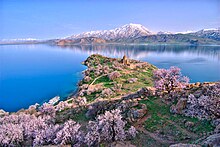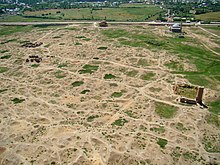VAN - NOW IN TURKEY
Van, Turkey
From Wikipedia, the free encyclopedia
| Van | |
|---|---|
| City | |
| Top left:Van railroad station, Top right:View of Van from Van Castle, Middle left: downtown Van city, Middle right:Van Ferit Melen Airport, Bottom left: Van Fortress, Bottom right: Armenian Cathedral of the Holy Cross | |
| Coordinates: 38°29′39″N 43°22′48″ECoordinates: 38°29′39″N 43°22′48″E | |
| Government | |
| • Mayor | Bekir Kaya (BDP) |
| Area[1] | |
| • District | 1,938.14 km2 (748.32 sq mi) |
| Elevation | 1,730 m (5,680 ft) |
| Population (2012)[2] | |
| • Urban | 370,190 |
| • District | 472,069 |
| • District Density | 240/km2 (630/sq mi) |
Van (Armenian: Վան) is a city in eastern Turkey's Van Province, located on the eastern shore of Lake Van. It is the cultural center of the area's Kurdish majority.[3] The city's population is mostly Kurdish. In 2010 the official population figure for Van was 367,419,[4] but many estimates put it much higher with a 1996 estimate stating 500,000[5] and former Mayor Burhan Yengun is quoted as saying it may be as high as 600,000.[6] The Van Central district stretches over 2,289 square kilometres (884 square miles)[7]
Contents
[hide]History
Archaeological excavations and surveys carried out in Van province indicate that the history of human settlement in this region goes back at least as far as 5000 BC. The Tilkitepe Mound, which is on the shores of Lake Van and a few kilometres to the south of Van Castle, is the only source of information about the oldest culture of Van.
Urartu
Under the ancient name of Tushpa, Van was the capital of the Urartian kingdom in the 9th century BC. The early settlement was centered on the steep-sided bluff now known as Van Castle (Van Kalesi), close to the edge of Lake Van and a few kilometers west of the modern city. Here have been found Urartiancuneiform inscriptions dating to the 8th and 7th centuries BC. In the trilingual Behistun inscription, carved in the order of Darius the Great of Persia, the country referred to as Urartu in Babylonian is called Armeniain Old Persian.
From the Orontids to the Kingdom of Armenia
The region came under the control of the Armenian Orontids in the 7th century BC and later Persians in the mid 6th century BC. In 331 BC, Van was conquered by Alexander the Great and after his death became part of the Seleucid Empire. By the early 2nd century BC it was part of the Kingdom of Armenia. It became an important center during the reign of the Armenian king, Tigranes II, who founded the city of Tigranakert in the 1st century BC.[9] This region was ruled by the Arsacid Dynasty of Armenia before 4th century AD. In the History of Armenia attributed to Moses of Chorene, the city is called Tosp, from Urartian Tushpa.[10]
The Byzantines and the kingdom of Vaspurakan
Main article: Vaspurakan
The Byzantine Empire briefly held the region from 628 to 640, after which it was invaded by the Muslim Arabs, who consolidated their conquests as the province of Ermeniye. Decline in Arab power eventually allowed local Armenianrulers to re-emerge, with the Artsruni dynasty soon becoming the most powerful. Initially dependent on the rulers of the Kingdom of Ani, they declared their independence in 908, founding Armenian kingdom of Vaspurakan. The kingdom had no specific capital: the court would move as the king transferred his residence from place to place, such as Van city, Vostan, Aghtamar, etc. In 1021 the last king of Vaspurakan, John-Senekerim Artsruni, ceded his entire kingdom to the Byzantine empire, who established the Vaspurakan theme on the former Artsruni territories.
The Seljuk Empire
Incursions by the Seljuk Turks into Vaspurakan started in the 1050s. After their victory in 1071 at thebattle of Manzikert the entire region fell under their control. After them, local Muslim rulers emerged, such as the Ahlatshahs and the Ayyubids (1207). For a 20 year period, Van was held by the Anatolian Seljuk Sultanate until the 1240s when it was conquered by the Mongols. In the 14th century, Van was held by theKara Koyunlu Turks, and later by the Timurids.
Ottoman era
See also: Eyalet of Van and Vilayet of Van
The first half of the 15th century saw the Van region become a land of conflict as it was disputed by theOttoman Empire and the Persian Safavid Empire. The Safavids captured Van in 1502. The Ottomans took the city in 1515 and held it for a short period. The Safavids took it again in 1520 and the Ottomans gained final and definite control of the city in 1548. They first made Van into a sanjak dependent on the Erzurum eyalet, and later into a separate Van eyalet in about 1570.
Towards the second half of the 19th century Van began to play an increased role in the politics of the Ottoman Empire due to its location near the borders of the Persian, Russian and Ottoman Empire, as well as its proximity to Mosul.
During the period leading up to the breakup of the Ottoman Empire, Armenians were well represented in the local administration.[11]
During the early 1900s, the city of Van had eleven Armenian schools and ten Turkish schools.[12]
Demographics
The demographics of Ottoman Van are a debated and contentious point as they relate directly to claims of ownership by either side prior to the outbreak of World War I. Based on the official 1914 Ottoman Census the population of Van province consisted of 179,422 Muslims and 67,797 Armenians.[13] The Ottoman Census figures include only male citizens, excluding women and children. According to a more recent research, the corrected estimates for Van province (including women and children) was; 313,000 Muslims, 130,000 Armenians, and 65,000 others, including Assyrians.[14]The demographics of Van are a greatly debated point given the changing of provincial borders. For example, in 1875 the province was divided and Van and Hakkari separated, only to be rejoined in 1888 which drastically changed the make up of any census, and some writers argue that this merging was done to keep the Armenians from forming a majority.[15] In 1862 it was estimated that in Van there were 90,100 Christians (including Syriac Christians) and 95,100 Muslims.[16] The French Consul in Van reported that in Van and Bitlis 51.46% were Kurds, 32.70 were Armenians and 5.53% were Turks.[17] On the other hand, the Armenian Patriarchate of Constantinople estimated 185,000 Armenians in Van, 180,000 Assyrian Jacobites, 72,000 Kurds, 47,000 Turks, 25,000 Yezidis and 3,000 Gypsis.[18] Both sides have been accused of overcounting the numbers at the time given the revival of the Armenian Question and population statistics became important during the Berlin Conference.[19]
World War I and Armenian Genocide
Main article: Siege of Van
The province's Armenian population was devastated during World War I by the Young Turks.[20] The regional administrator, Cevdet Bey, was reported to have said that "We have cleansed the Armenians and Syriac [Christian]s from Azerbaijan, and we will do the same in Van.[21] Numerous reports from Ottoman officials, such as a parliament deputy, the governor of Allepo as well as the German consul in Van, suggested that deliberate provocations against the Armenians were being orchestrated by the local government.[21] In Mid-April 1915, Cevdet Bey ordered the execution of four Armenian leaders,[22][23] which drove the Armenians to take up arms in self-defense.[24] On the other hand, writer and genocide scholar Taner Akçam acknowledges that in the case of Van, the deportations may have been driven by military necessity[25] and states the resistance in Van should be examined as a separate case.[26]
Some scholars explain that the Armenians launched a rebellion at Van in 1915, lured by Russian promises of independence. Other scholars argue that the Armenian residents, hoping to avoid the slaughter being inflicted on the rural populations surrounding Van, defended themselves in the Armenian quarters of the city against the Turks.[27] The Russians finally relieved the Armenian defenders of Van in late May 1915. In August, a victory over the Russian army allowed the Ottoman army to retake Van. In September 1915, the Russians forced the Turks out of Van for the second time. Russian forces began to leave the area after the October Revolution in Russia in 1917, and by April 1918, it was recaptured by the Ottoman army. According to Taner Akçam, citing the Osmanli Belgelerinde Ermeniler 1915–1920 (Armenians in Ottoman Documents, 1915–1920), after the Turks took back the city from the Russians, they killed all Armenians in the city.[28] The end of World War I forced the Ottoman army to surrender its claim to Van, although it stayed in Turkish hands following the Turkish War of Independence.[citation needed]
Turkish War of Independence and Republic
In the Treaty of Sèvres, the Entente Powers decided to cede the city to the Democratic Republic of Armenia. Turkish revolutionaries, led by Mustafa Kemal Atatürkrejected the terms of the treaty and instead waged the Turkish War of Independence. However the idea of ceding Van to the Armenians was floated, and Ismet Inonu was said to have surveyed army officers on 14 October 1919 on the issue of ceding Van and Bitlis. However the parliament in Ankara rejected any compromise on this issue.[29][page needed]By 1920, Van fell under Turkish control again and its remaining Armenian inhabitants were expelled in a final round ofethnic cleansing.[27] With the Treaty of Lausanne and Treaty of Kars, the Treaty of Sèvres was annulled and Van remained officially under Turkish sovereignty.
By the end of the conflicts, the town of Van was empty and in ruins. The city was rebuilt after the war a few kilometers east of the ancient citadel, which is now known as Van Castle (Van Kalesi). The city now lies at about 1,750 metres (5,741 feet) above sea level.










No comments:
Post a Comment